2023 TOYOTA 86 airbag
[x] Cancel search: airbagPage 47 of 449
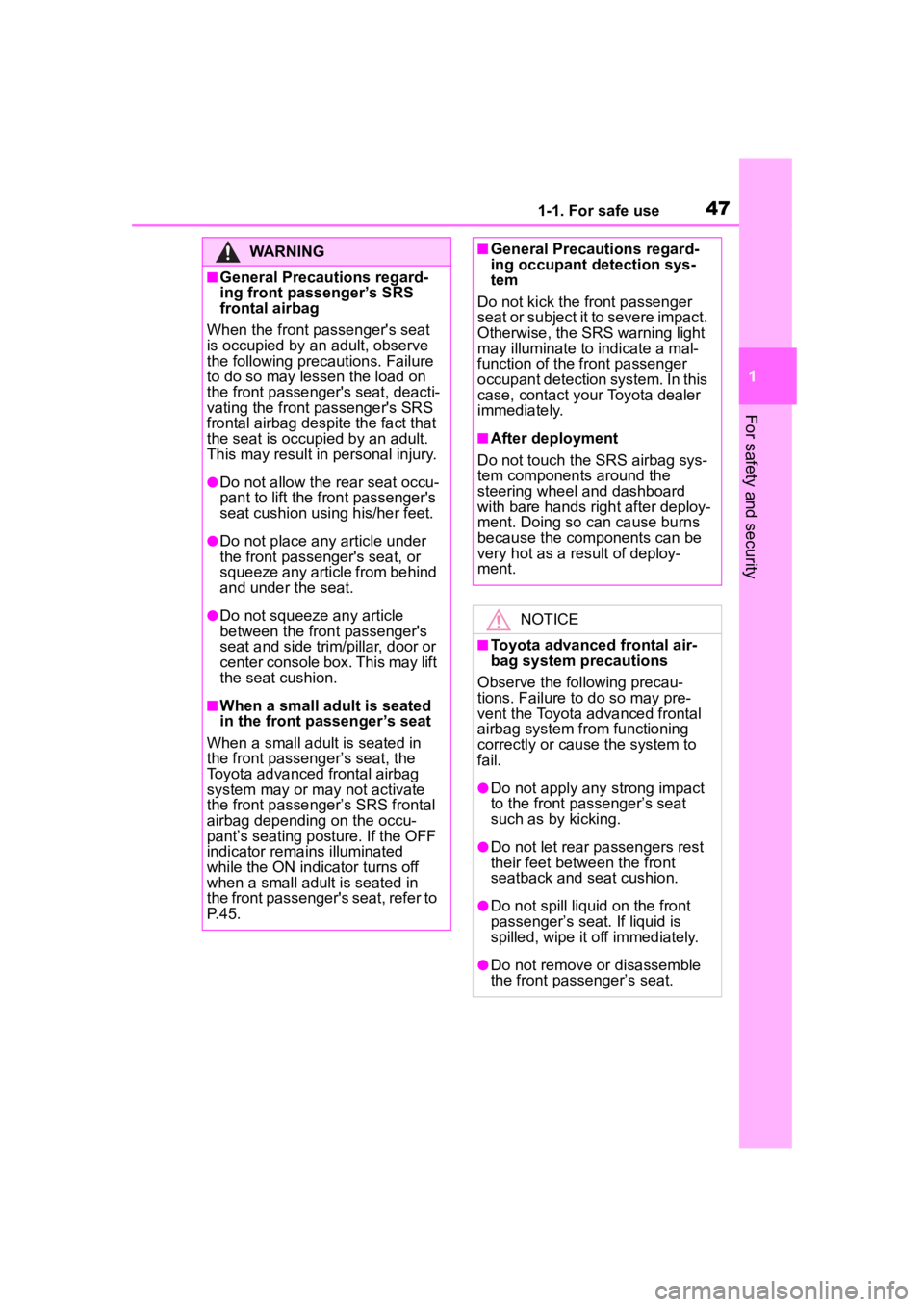
471-1. For safe use
1
For safety and security
WARNING
■General Precautions regard-
ing front passenger’s SRS
frontal airbag
When the front passenger's seat
is occupied by an adult, observe
the following precautions. Failure
to do so may lessen the load on
the front passenger 's seat, deacti-
vating the front passenger's SRS
frontal airbag despite the fact that
the seat is occupied by an adult.
This may result in personal injury.
●Do not allow the rear seat occu-
pant to lift the front passenger's
seat cushion using his/her feet.
●Do not place any article under
the front passenger's seat, or
squeeze any article from behind
and under the seat.
●Do not squeeze any article
between the front passenger's
seat and side trim/pillar, door or
center console box. This may lift
the seat cushion.
■When a small a dult is seated
in the front passenger’s seat
When a small adult is seated in
the front passeng er’s seat, the
Toyota advanced frontal airbag
system may or may not activate
the front passenger’s SRS frontal
airbag depending on the occu-
pant’s seating posture. If the OFF
indicator remains illuminated
while the ON indi cator turns off
when a small adult is seated in
the front passenger's seat, refer to
P. 4 5 .
■General Precautions regard-
ing occupant detection sys-
tem
Do not kick the front passenger
seat or subject it to severe impact.
Otherwise, the SRS warning light
may illuminate to indicate a mal-
function of the front passenger
occupant detection system. In this
case, contact your Toyota dealer
immediately.
■After deployment
Do not touch the SRS airbag sys-
tem components around the
steering wheel and dashboard
with bare hands right after deploy-
ment. Doing so can cause burns
because the components can be
very hot as a result of deploy-
ment.
NOTICE
■Toyota advanced frontal air-
bag system precautions
Observe the following precau-
tions. Failure to do so may pre-
vent the Toyota advanced frontal
airbag system from functioning
correctly or cause the system to
fail.
●Do not apply any strong impact
to the front passenger’s seat
such as by kicking.
●Do not let rear passengers rest
their feet between the front
seatback and seat cushion.
●Do not spill liquid on the front
passenger’s seat. If liquid is
spilled, wipe it o ff immediately.
●Do not remove or disassemble
the front passenger’s seat.
Page 48 of 449
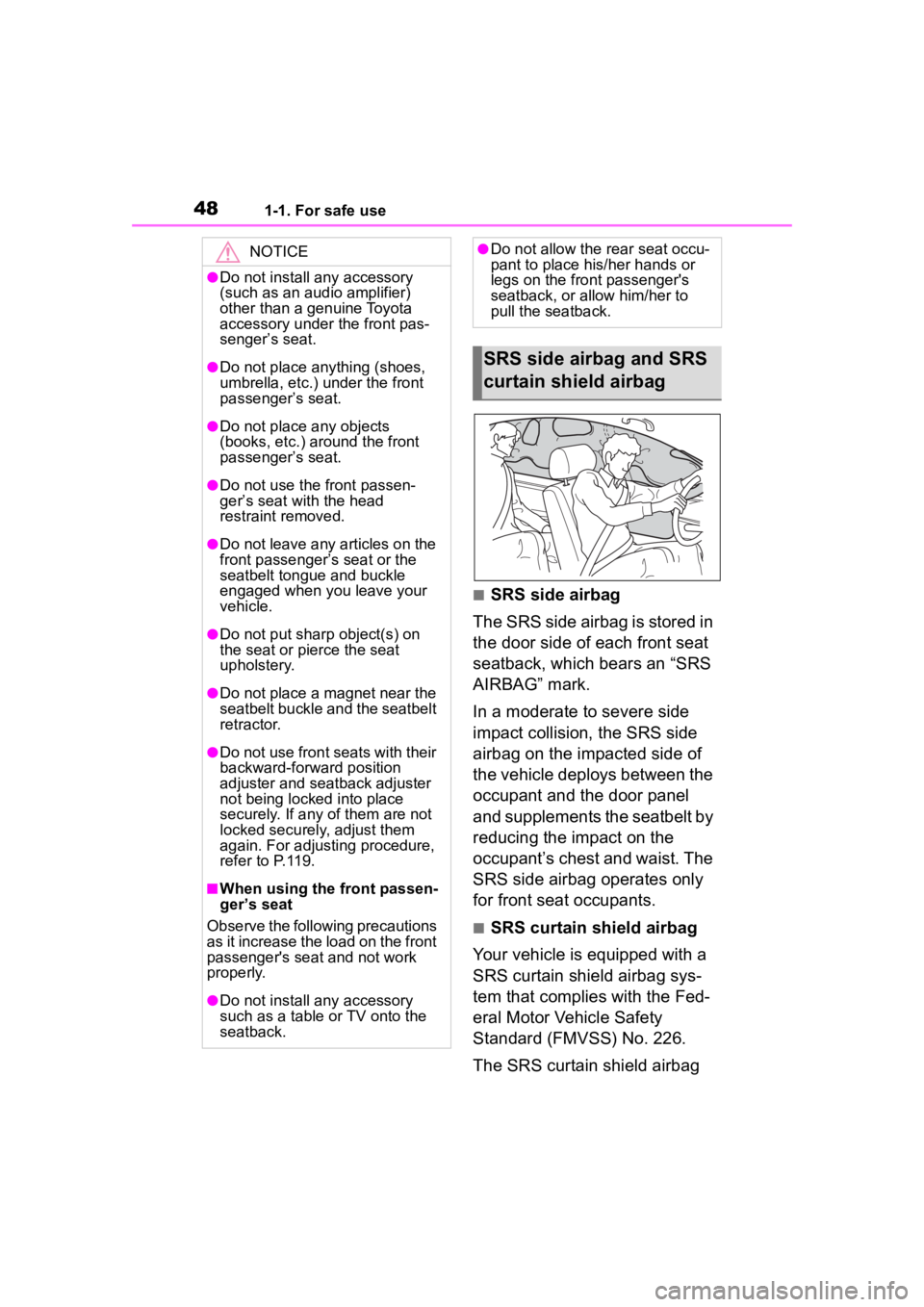
481-1. For safe use
■SRS side airbag
The SRS side airbag is stored in
the door side of each front seat
seatback, which bears an “SRS
AIRBAG” mark.
In a moderate to severe side
impact collision, the SRS side
airbag on the impacted side of
the vehicle deploys between the
occupant and the door panel
and supplements the seatbelt by
reducing the impact on the
occupant’s chest and waist. The
SRS side airbag operates only
for front seat occupants.
■SRS curtain shield airbag
Your vehicle is equipped with a
SRS curtain shield airbag sys-
tem that complies with the Fed-
eral Motor Vehicle Safety
Standard (FMVSS) No. 226.
The SRS curtain shield airbag
NOTICE
●Do not install any accessory
(such as an audio amplifier)
other than a genuine Toyota
accessory under the front pas-
senger’s seat.
●Do not place anything (shoes,
umbrella, etc.) under the front
passenger’s seat.
●Do not place any objects
(books, etc.) around the front
passenger’s seat.
●Do not use the front passen-
ger’s seat with the head
restraint removed.
●Do not leave any articles on the
front passenger’ s seat or the
seatbelt tongue and buckle
engaged when you leave your
vehicle.
●Do not put sharp object(s) on
the seat or pierce the seat
upholstery.
●Do not place a magnet near the
seatbelt buckle and the seatbelt
retractor.
●Do not use front seats with their
backward-forward position
adjuster and seatback adjuster
not being locked into place
securely. If any of them are not
locked securely, adjust them
again. For adjusting procedure,
refer to P.119.
■When using the front passen-
ger’s seat
Observe the following precautions
as it increase the load on the front
passenger's seat and not work
properly.
●Do not install any accessory
such as a table or TV onto the
seatback.
●Do not allow the rear seat occu-
pant to place his/her hands or
legs on the front passenger's
seatback, or allow him/her to
pull the seatback.
SRS side airbag and SRS
curtain shield airbag
Page 49 of 449

491-1. For safe use
1
For safety and security
on each side of the cabin is
stored in the roof side (between
the front pillar and a point over
the rear seat). An “SRS AIR-
BAG” mark is located at the top
of each center pillar.
In a moderate to severe side
i m p a c t c o l l i s i o n , t h e S R S c u r t a i n
shield airbag on the impacted
side of the vehicle deploys
between the occupant and the
side window and supplements
the seatbelt by reducing the
impact on the occupant’s head.
In a rollover, SRS curtain shield
airbags on both sides of the
vehicle deploy between the
occupant and the side window
and supplement the seatbelt by
reducing the impact to the occu-
pant’s head.
In an offset frontal collision, SRS
curtain shield airbags on both
sides of the vehicle deploy
between the occupant and the
side window and supplement
the seatbelt by reducing the
impact to the occupant’s head
and chest.
■Operation
The SRS side airbag and SRS
curtain shield airbag can func-
tion only when the engine switch
is in ON.
The following airbags deploy
independently of each other
since each has its own impact
sensor.
Driver’s SRS side airbag
Front passenger’s SRS side
airbag
SRS curtain shield airbag
(right-hand side)
SRS curtain shield airbag
(left-hand side)
Therefore, they may not both
deploy in the same accident.
Also, the SRS side airbag and
SRS curtain shield airbag
deploys independently of the
driver’s and front passenger’s
SRS frontal airbags in the steer-
ing wheel and instrument panel.
For the locations of the sensors
and control modules, refer to
P. 2 9 .
■After deployment
After the deployment, the SRS
side airbag immediately starts to
deflate. The time required from
detection of an impact to defla-
tion of an SRS side airbag after
deployment is shorter than the
blink of an eye.
The SRS curtain shield airbag
remains inflated for a while fol-
lowing deployment then slowly
deflates.
The SRS side airbag and SRS
curtain shield airbag deploy
even when no one occupies the
seat on the side on which an
impact is applied.
When the SRS side airbag and
SRS curtain shield airbag
Page 50 of 449
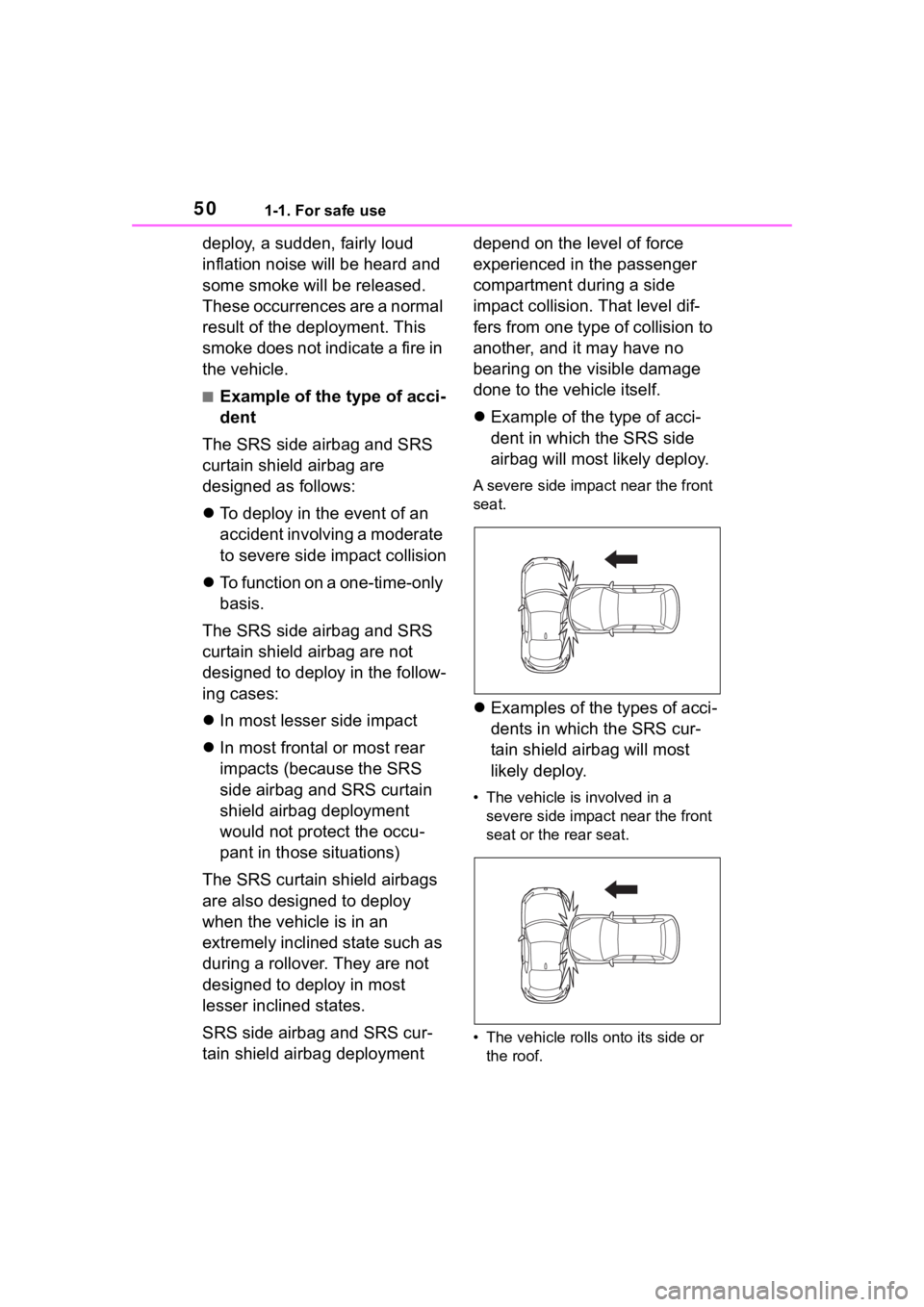
501-1. For safe use
deploy, a sudden, fairly loud
inflation noise will be heard and
some smoke will be released.
These occurrences are a normal
result of the deployment. This
smoke does not indicate a fire in
the vehicle.
■Example of the type of acci-
dent
The SRS side airbag and SRS
curtain shield airbag are
designed as follows:
To deploy in the event of an
accident involving a moderate
to severe side impact collision
To function on a one-time-only
basis.
The SRS side airbag and SRS
curtain shield airbag are not
designed to deploy in the follow-
ing cases:
In most lesser side impact
In most frontal or most rear
impacts (because the SRS
side airbag and SRS curtain
shield airbag deployment
would not protect the occu-
pant in those situations)
The SRS curtain shield airbags
are also designed to deploy
when the vehicle is in an
extremely inclined state such as
during a rollover. They are not
designed to deploy in most
lesser inclined states.
SRS side airbag and SRS cur-
tain shield airbag deployment depend on the level of force
experienced in the passenger
compartment during a side
impact collision. That level dif-
fers from one type of collision to
another, and it may have no
bearing on the visible damage
done to the vehicle itself.
Example of the type of acci-
dent in which the SRS side
airbag will most likely deploy.
A severe side impact near the front
seat.
Examples of the types of acci-
dents in which the SRS cur-
tain shield airbag will most
likely deploy.
• The vehicle is involved in a
severe side impact near the front
seat or the rear seat.
• The vehicle rolls o nto its side or
the roof.
Page 51 of 449
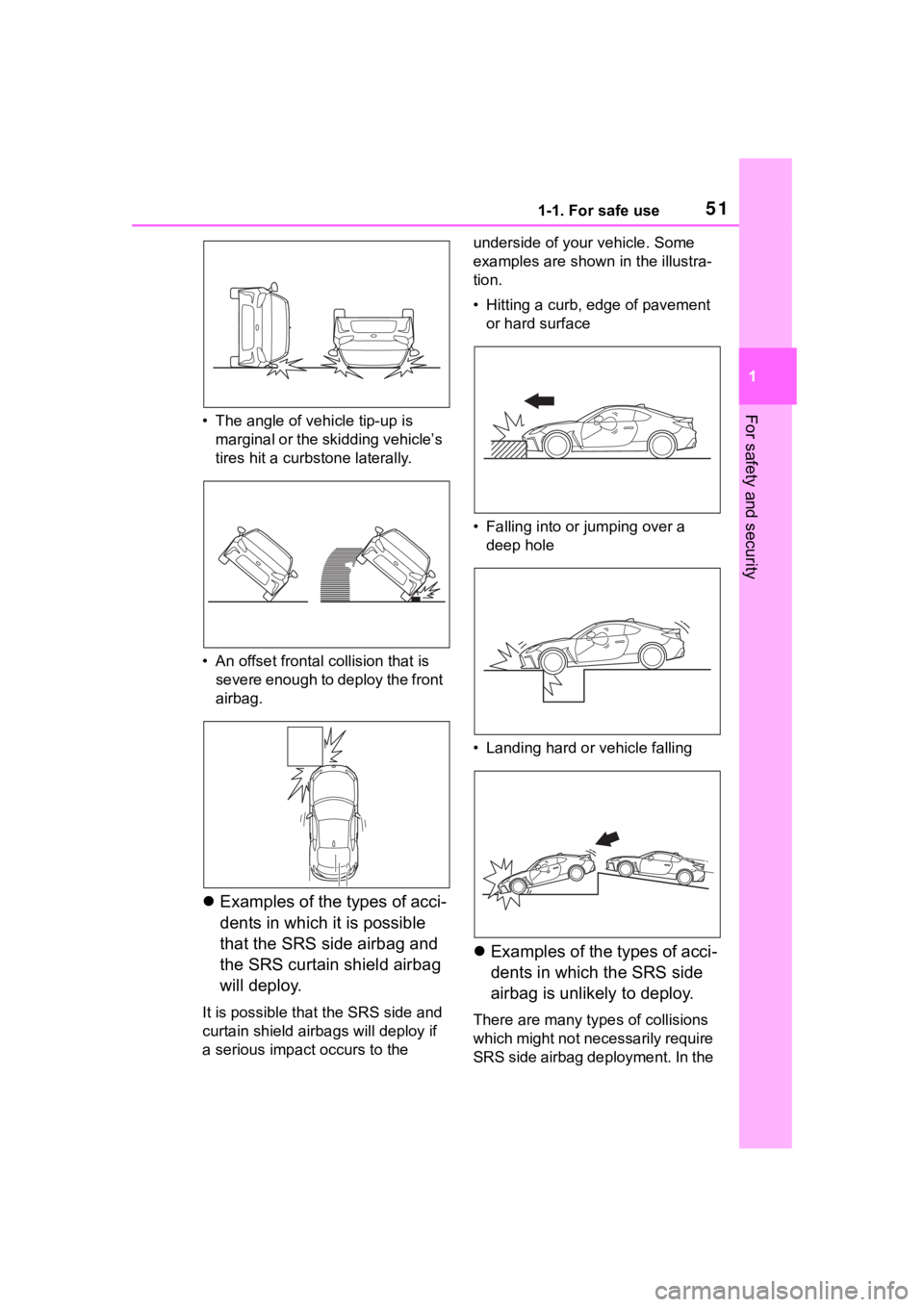
511-1. For safe use
1
For safety and security• The angle of vehicle tip-up is marginal or the skidding vehicle’s
tires hit a curbstone laterally.
• An offset frontal collision that is
severe enough to deploy the front
airbag.
Examples of the types of acci-
dents in which it is possible
that the SRS side airbag and
the SRS curtain shield airbag
will deploy.
It is possible that the SRS side and
curtain shield air bags will deploy if
a serious impact occurs to the underside of your vehicle. Some
examples are shown
in the illustra-
tion.
• Hitting a curb, edge of pavement or hard surface
• Falling into or jumping over a
deep hole
• Landing hard or vehicle falling
Examples of the types of acci-
dents in which the SRS side
airbag is unlikely to deploy.
There are many types of collisions
which might not necessarily require
SRS side airbag deployment. In the
Page 52 of 449

521-1. For safe use
event of accidents like those illus-
trated, the SRS side airbag may not
deploy depending on the level of
accident forces involved.
• The vehicle is involved in an oblique side-on impact.
• The vehicle is involved in a side-on impact in an area outside
the vicinity of the passenger com-
partment.
• The vehicle strikes a telephone pole or similar object.
• The vehicle is involved in a side-on impact from a motorcycle. • The vehicle rolls o
nto its side or
the roof.
Examples of the types of acci-
dents in which the SRS cur-
tain shield airbag is unlikely to
deploy.
There are many types of collisions
which might not necessarily require
SRS curtain shield airbag deploy-
ment. In the event of accidents like
those illustrated, the SRS curtain
shield airbag may not deploy
depending on the level of accident
forces involved.
• The vehicle is involved in an
oblique side-on impact.
Page 53 of 449
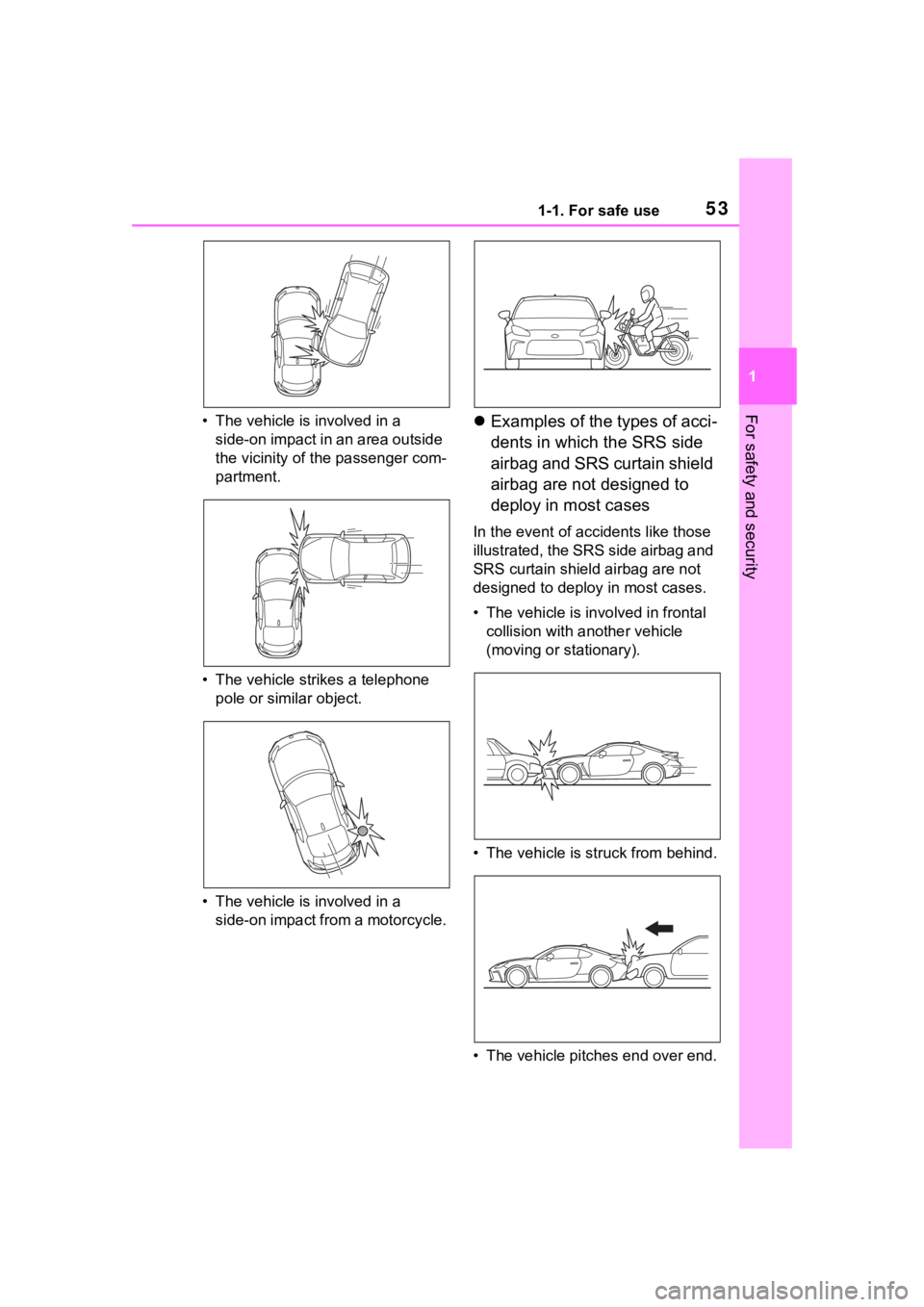
531-1. For safe use
1
For safety and security• The vehicle is involved in a side-on impact in an area outside
the vicinity of the passenger com-
partment.
• The vehicle strikes a telephone pole or similar object.
• The vehicle is involved in a side-on impact from a motorcycle. Examples of the types of acci-
dents in which the SRS side
airbag and SRS curtain shield
airbag are not designed to
deploy in most cases
In the event of accidents like those
illustrated, the SRS side airbag and
SRS curtain shield airbag are not
designed to deploy in most cases.
• The vehicle is involved in frontal
collision with another vehicle
(moving or stationary).
• The vehicle is struck from behind.
• The vehicle pitches end over end.
Page 54 of 449

541-1. For safe use
In an accident where the vehicle
is struck from the side more
than once, the SRS side airbag
and SRS curtain shield airbag
deploy only once on the first
impact.
Example: In the case of a dou-
ble side impact collision, first
with one vehicle and immedi-
ately followed by another from
the same direction, once the
SRS side airbag and SRS cur-
tain shield airbag are activated
on the first impact, they will not
be activated on the second.SRS curtain shield airbag
SRS side airbag
1 First impact
2 Second impact A diagnostic system continually
monitors the readiness of the
SRS airbag system (including
seatbelt pretensioners) with the
engine switch is in ON. The
SRS warning light will show nor-
mal system operation by illumi-
nating for approximately 6
seconds when the engine switch
is turned to ON.
The following components are
monitored by the indicator:
A
WARNING
■After deployment
●Do not touch the SRS side air-
bag system components around
the front seat seatback with
bare hands right after deploy-
ment. Doing so can cause burns
because the components can
be very hot as a result of
deployment.
●After deployment
, do not touch
any part of the SRS curtain
shield airbag sys tem (from the
front pillar to the part of the roof
side over the rear seat). Doing
so can cause burns because
the components can be very hot
as a result of deployment.
SRS Airbag System Moni-
tors